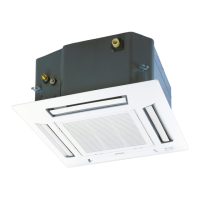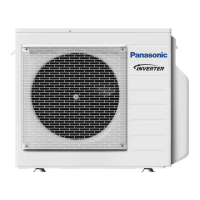Why does the outdoor unit of my Panasonic CU-4E27QBR Air Conditioner emit water or steam?
- Aautumn68Aug 26, 2025
The outdoor unit of your Panasonic Air Conditioner emits water or steam because condensation or evaporation occurs on the pipes.
Why does the outdoor unit of my Panasonic CU-4E27QBR Air Conditioner emit water or steam?
The outdoor unit of your Panasonic Air Conditioner emits water or steam because condensation or evaporation occurs on the pipes.
Why does the POWER indicator blink on my Panasonic CU-4E27QBR before turning it on?
The POWER indicator might blink before you switch on your Panasonic Air Conditioner because the unit is preparing for operation when the ON timer has been set.
What does it mean when the POWER indicator blinks and the indoor fan stops on my Panasonic CU-4E27QBR?
The POWER indicator blinking during operation with the indoor fan stopped indicates that your Panasonic Air Conditioner is in defrost mode. During this process, melted frost is being drained from the outdoor unit.
Why is the TIMER indicator always on in my Panasonic Air Conditioner?
The timer setting on your Panasonic Air Conditioner repeats daily once it has been initially set.
Why does my Panasonic CU-4E27QBR Air Conditioner's outdoor unit emit water or steam?
The water or steam emitted from the outdoor unit of your Panasonic Air Conditioner is due to condensation or evaporation occurring on the pipes.
Why is the TIMER indicator always on for my Panasonic Air Conditioner?
The TIMER indicator remains on because the timer setting repeats daily once it has been set.
How to improve the efficiency of HEAT/COOL mode on my Panasonic CU-4E27QBR?
If your Panasonic Air Conditioner's HEAT/COOL mode isn't working efficiently, make sure you've set the temperature correctly. Also, ensure all doors and windows are closed, clean or replace the filters, and clear any obstructions at the air inlet and outlet vents.
Why is the TIMER indicator always on on my Panasonic CU-4E27QBR Air Conditioner?
The TIMER indicator on your Panasonic Air Conditioner remains on because the timer setting repeats daily once it has been set.
What to do if the Panasonic CU-4E27QBR Air Conditioner stops and the TIMER indicator is blinking?
If your Panasonic Air Conditioner unit stops and the TIMER indicator blinks, use the remote control to retrieve the error code.
What to do if my Panasonic CU-4E27QBR does not receive the signal from the remote control?
If the Panasonic Air Conditioner unit is not receiving the signal from the remote control, ensure that the receiver is not obstructed. Note that certain fluorescent lights may interfere with the signal transmitter; consult an authorized dealer for assistance.
Steps to prepare the remote control for operation, including setting time.
How to start the unit, select modes (AUTO, HEAT, COOL, DRY), and set temperature.
General safety instructions, warning symbols, and prohibitory actions for safe operation.
Warnings and precautions for operating the indoor and outdoor units safely.
Precautions related to power supply, cords, and earthing to prevent hazards.
Cautions for indoor/outdoor units regarding cleaning, airflow, fins, and installation.
Explanation of the remote control's display icons and indicators.
Instructions on how to choose operating modes like AUTO, HEAT, COOL, and DRY.
How to activate QUIET and POWERFUL modes for different operational needs.
Guide on how to adjust the fan speed settings for the air conditioner.
Details regarding the collection and disposal of old equipment.
Instructions for setting daily timers to turn the unit ON or OFF at specific times.
Conditions that indicate the unit requires professional servicing.
Guide to set up to 6 programmes per day for energy saving.
How to check, modify, add, or cancel timer programmes.
Instructions to enable or disable the weekly timer feature.
Lists common occurrences that are not actual unit defects.
Actions to take before contacting service for operational issues.
Lists actual malfunction symptoms and how to check them using the remote.
Steps to prepare the remote control for operation, including setting time.
How to start the unit, select modes (AUTO, HEAT, COOL, DRY), and set temperature.
General safety instructions, warning symbols, and prohibitory actions for safe operation.
Warnings and precautions for operating the indoor and outdoor units safely.
Precautions related to power supply, cords, and earthing to prevent hazards.
Cautions for indoor/outdoor units regarding cleaning, airflow, fins, and installation.
Explanation of the remote control's display icons and indicators.
Instructions on how to choose operating modes like AUTO, HEAT, COOL, and DRY.
How to activate QUIET and POWERFUL modes for different operational needs.
Guide on how to adjust the fan speed settings for the air conditioner.
Details regarding the collection and disposal of old equipment.
Instructions for setting daily timers to turn the unit ON or OFF at specific times.
Conditions that indicate the unit requires professional servicing.
Guide to set up to 6 programmes per day for energy saving.
How to check, modify, add, or cancel timer programmes.
Instructions to enable or disable the weekly timer feature.
Lists common occurrences that are not actual unit defects.
Actions to take before contacting service for operational issues.
Lists actual malfunction symptoms and how to check them using the remote.
| Brand | Panasonic |
|---|---|
| Model | CU-4E27QBR |
| Category | Air Conditioner |
| Language | English |












